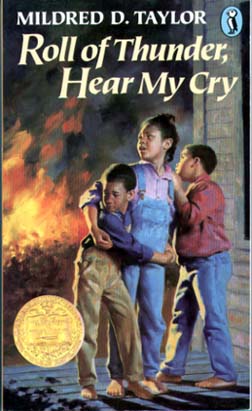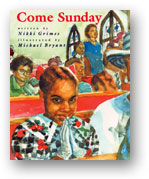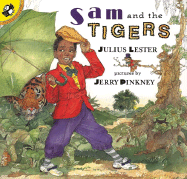[ Home ]

African-American Literature
 Taylor,
Mildred. Roll of thunder, hear my
cry. New York
: Dial,
1996. ISBN 0-8037-7473-7.
Taylor,
Mildred. Roll of thunder, hear my
cry. New York
: Dial,
1996. ISBN 0-8037-7473-7.
Awards:
Newbery Medal
,
ALA
Notable Book
Roll of Thunder, Hear My Cry is
Taylor
’s second book about the Logans, a black family living in
Mississippi
during the Depression. The
Logans
own the land they live on, which was unusual during the time. The Logan children
experience and witness daily acts of racism by the local townspeople, including
the school bus driver, who “entertains” his White riders by speeding through
mud puddles, just to splash the Black children as they walk to and from school.
In addition to having to endure ongoing racial indignities, the
Logans
must deal with Harlan Granger, who intends to take their land from them one way
or another.
Things heat up when the
Logans
organize a boycott against the Wallace family store, after the Wallaces were
involved in a “burning” and never faced any consequences. The
Logans
try to empower other Black families by arranging for them to have credit at a
different store in a nearby town. One night, after a white store-owner was
killed, the “nightmen” surrounded the home of T.J. Avery, the Logan
children’s friend. In order to divert the mob’s attention elsewhere, David
Logan sets his cotton fields on fire. The
Logan
property is located right next to Harlan Granger’s land and Granger orders the
white men to help extinguish the fire in order to save his own land. Luckily for
T.J., lawyer and long-time
Logan
family friend, Mr. Jamison, was able to secure T.J. and have him taken to jail.
Several themes run throughout this story:
racism and its effects, survival and perseverance, friendship, loyalty,
and family.
The cultural markers are evident in the story. Deep South
Black dialect is used throughout the story. The
Logan
children speak to their parents and grandmother with great respect, as had been
traditionally taught in the South.
Taylor
describes the physical characteristics of the characters with such detail as,
“Her clear, smooth skin was the color of a pecan shell.”
Taylor
’s descriptions of the atrocities are not overly graphic, but are descriptive
enough to paint a vivid picture of what was going on. The story would hold the
interest of adolescent readers since the protagonist is a nine year old girl,
with brothers and friends who are a bit older than she is. The children,
although set in the South in the 30’s, do things that all children have done
at some point…..walk to school, disobey their parents, eavesdrop on adults,
etc.
There are no illustrations in this book, other than the
frontispiece, which was done by well-known author/illustrator Jerry Pinkney. The
illustration depicts Mr. and Mrs. Logan, Big Ma, family friend and hired hand,
Mr. Morrison, Cassie, and her brother Stacey. The characters are shown in
clothing that would be commonly worn during the Depression.
This story would be very appropriate to use in the study of
the racial injustices faced by Blacks in the South. It is an accurate depiction
of what life must have been like for Black families during this time in American
history.
 Grimes,
Nikki. Come Sunday. Grand Rapids,
Michigan: Eerdmans Publishing, 1996. ISBN 0-8028-5108-8.
Grimes,
Nikki. Come Sunday. Grand Rapids,
Michigan: Eerdmans Publishing, 1996. ISBN 0-8028-5108-8.
Awards: ALA
Notable Book
This is a collection of fourteen short poems that illustrate a little girl’s
“bed-to-bed” experience on a typical Sunday. The first poem, which is the
title poem, begins with LaTasha’s mother waking her up on a Sunday morning.
She has a hard time sitting still because her mother is braiding her hair for
church. The next poem is one that most people will relate to; Blue-Haired
Ladies tells about the church ladies who must always pinch LaTasha’s
cheeks!
One poem that successfully depicts the Sunday church experience of Black
Americans, particularly in the South, is Ladies’
Hats. LaTasha sits in awe of the beautiful hats the ladies wear to church on
Sundays. She loves the ribbons and bows and the vibrant colors. The
illustrations, by Michael Bryant, show the women sitting in the pews, wearing
their hats. Grimes uses LaTasha’s voice to lead us through the rest of the
events at Paradise Baptist Church on that given Sunday, including LaTasha’s
own baptism, the church supper, and finally Lights
Out.
One particularly enjoyable poem is My
Offering, in which LaTasha tells how she feels uncomfortable with the fact
that everyone at church knows when she is holding a little bit of her money back
from the offering. She only does so when she needs an ice cream cone, and when
she has one, she offers “God a lick.”
The Sunday activities described in Grimes’ poems give the
reader a real sense of the Black-American Southern Baptist Church experience.
The description of the “walking in music” and the “drums and
tambourines” help create an image in the reader’s head. Michael Bryant’s
illustrations help add to the sense of what
Paradise
Baptist
Church
would be like on any given Sunday. The use of various shades of brown in the
character’s skin tones helps with the authenticity of the experience. Grimes
adds to the visual experience with a description of LaTasha’s mother’s
“chocolatey-brown skin.”
 Lester,
Julius. Sam and the tigers.
New York: Dial
Books, 1996. ISBN 0-8037-2028-9.
Lester,
Julius. Sam and the tigers.
New York: Dial
Books, 1996. ISBN 0-8037-2028-9.
This is the new telling of Helen Bannerman’s Little
Black Sambo without the negative imagery of the original Black characters.
The story is the same: Sam is
shopping for new clothes with his parents, Sam and Sam. (In fact, everyone who
lives in Sam-sam-sa-mara is named Sam.) The inhabitants of the Sam-sam-sa-mara
are an interesting mixture of human beings and animals, but no one seems to
notice the difference! Sam picks out the most brilliantly colored clothes and
accessories he can find. On his way
to school one morning, Sam is threatened by a hungry tiger. He trades an article
of clothing for his life and continues on his way, only to meet another hungry
tiger. The cycle continues until Sam is standing in nothing but his underwear.
Sam sees the tigers in a clearing and see that they are all quarreling with one
another, each trying to establish his superiority over the others. The tigers
remove their article of clothing and begin to wrestle and fight. Sam quickly
gathers his clothes and taunts the tigers by asking, “Ain’t I fine?” The
tigers become so angry that they run themselves into a pool of melted butter.
Sam collects the butter and convinces his mother to make pancakes. They invite
their neighbors over for dinner, all of whom are animals, including Brer Fox and
Brer Wolf.
Lester adds several modern day touches to the story. Sam reminds one of the
tigers that his cholesterol will go way up if he eats him!
Another contemporary touch becomes evident when one of the tigers calls
the others “losers.” This is a fun
Jerry Pinkney’s watercolor illustrations are bright and colorful.
Pinkney gave each tree a face, giving even more life to the already lively
pictures.
 Woodson,
Jacqueline. I hadn’t meant to
tell you this. New York: Delacorte
Press, 1996.
ISBN 0-385-32031-0.
Woodson,
Jacqueline. I hadn’t meant to
tell you this. New York: Delacorte
Press, 1996.
ISBN 0-385-32031-0.
Awards: Coretta
Scott King Award
POWERFUL.
That is the best word to describe this novel by Jacqueline Woodson.
Woodson begins the novel with a discussion about the town in which the story is
set. She describes how
Chauncey
,
Ohio
becomes an all-black suburb, inhabited by middle-class Black families.
Marie is a twelve year old Black girl whose father is a college professor and
whose mother walked out on.
Lena
, new to the school, is a poor white girl, whose mother had died. The two girls
seem to be mysteriously drawn to each other, maybe because neither of them has a
mother in the picture. Marie and
Lena
become very close friends despite the tensions presented by Marie’s Black
friends, particularly Sherry. Sherry taunts both girls, calling them WT (for
Whitetrash) and UT (for Uncle Tom).
Lena
is teased because she “talks like a black girl.” Marie
and
Lena
also must deal with tensions from their fathers, as neither is very tolerant of
the other’s race.
Lena
reveals to Marie that her father is sexually abusing her. The girls’
friendship is tested as Marie struggles with whether or not to tell someone
about the problem. The girls’ alliance becomes strengthened as they deal with
their mothers’ absences, racial tensions, and the abuse, in addition to common
adolescent issues such as teen cliques, peer pressure, etc.
Lena
and Marie become very best friends, but as
Lena
suddenly becomes distant, Marie realizes something is wrong.
Lena
reveals that her father is now molesting her younger sister.
Lena
tells Marie that she and her sister must flee from the situation. Marie must
deal with being abandoned once again.
Woodson creates an interesting situation with the questions
of racial identities. Marie teases
Lena
about talking like a black girl and having a black girl name, while
Lena
responds by putting the ball back in Marie’s court by saying maybe she is
just “light-skinned.”
![]()
 Taylor,
Mildred. Roll of thunder, hear my
cry. New York
: Dial,
1996. ISBN 0-8037-7473-7.
Taylor,
Mildred. Roll of thunder, hear my
cry. New York
: Dial,
1996. ISBN 0-8037-7473-7.  Grimes,
Nikki. Come Sunday.
Grimes,
Nikki. Come Sunday.  Lester,
Julius. Sam and the tigers.
Lester,
Julius. Sam and the tigers.  Woodson,
Jacqueline. I hadn’t meant to
tell you this.
Woodson,
Jacqueline. I hadn’t meant to
tell you this.